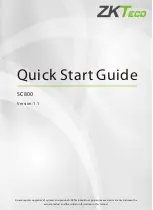
5 Commissioning
11.03
5.4 NCK acceptance test support
© Siemens AG 2003 All Rights Reserved
5-288
SINUMERIK 840D/SIMODRIVE 611 digital SINUMERIK Safety Integrated (FBSI) - Edition 11.03
5.4 NCK acceptance test support
The requirements associated with an acceptance test can be derived from the
EU Machinery Directive. Presently IEC 22G WG 10 is working on a standard for
"functional safety". This also includes a specific description of the requirements
for an acceptance test. Accordingly, the machinery construction (OEM) is
responsible for the following:
•
to carry-out an acceptance test for safety-relevant functions and machine
parts, and
•
to issue an "Acceptance certificate" that includes the results of the test.
When using the Safety Integrated function, the acceptance test is used to
check the functionality of the SI monitoring functions used in the NCK, PLC and
drive. In this case, the correct implementation of the defined safety functions is
investigated, the implemented test mechanisms checked (forced checking
procedure measures) as well as the response of individual monitoring
functions, provoked by individually violating the tolerance limit. This should be
carried-out for the safety functions that were implemented using SPL as well as
all of the axial monitoring functions of the axes that are monitored with SI.
Previously, the result of the test was a manually created document (refer to
Section 5.2). The test steps required were accompanied, in some instances, by
changes made to the PLC program and to MD settings and the alarms that
were issued were documented. Further, servo trace plots were evaluated using
the associated measuring function and the results and graphics transferred into
a document that the OEM had created. The principle contents and structure of
such a document is described in Chapter 5.2 "Acceptance report".
Based on this method, the existing SI functionality was expanded in the NCK
and drive software in order, in conjunction with an operator interface (SinuCom
NC), to support and simplify the test procedure as well as the associated
documentation.
The objective of this support is to control the creation and administration of an
acceptance report and prepare and carry-out the required test steps using the
appropriate operator actions via the operator interface. The test steps that are
required as part of the acceptance test are not fully automatically executed but
are controlled using a skilled operator. This operator must carry-out the
measures, associated with the test step, at the system being tested.
The following mechanisms are applied in order to carry-out the test steps and
to optimize the creation of the acceptance report:
•
Support when documenting the active monitoring functions and monitoring
limit values by reading-out the appropriate machine data.
•
Support when documenting the checksum values.
•
Standardization of the procedure when carrying-out the test, following a
pre-defined test list.
•
The test time is reduced by preparing test procedures within the system,
automatic trace and evaluation techniques and reduced time when
acknowledging SI alarms that are output.
General
















































